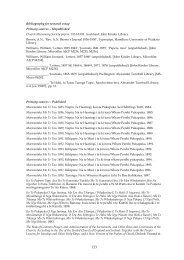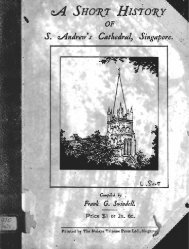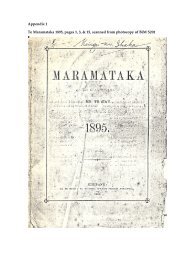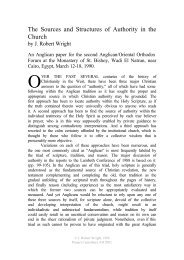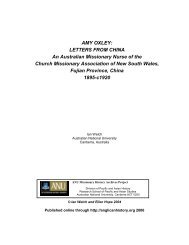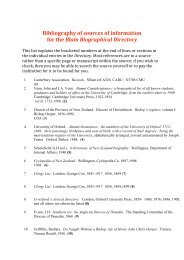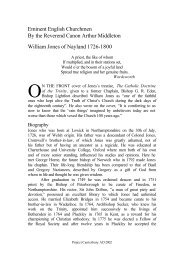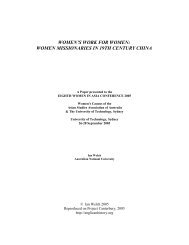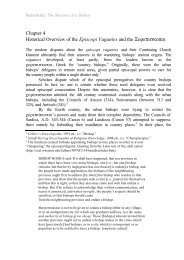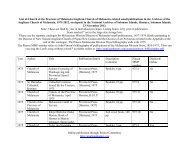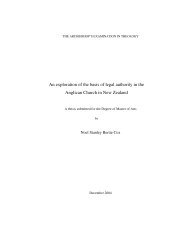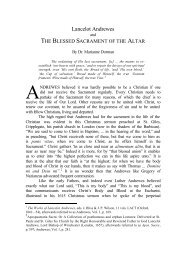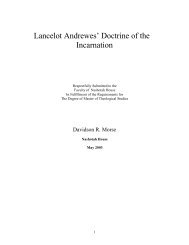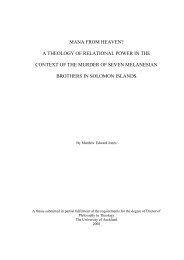The Influence of John Mason Neale and the - Project Canterbury
The Influence of John Mason Neale and the - Project Canterbury
The Influence of John Mason Neale and the - Project Canterbury
Create successful ePaper yourself
Turn your PDF publications into a flip-book with our unique Google optimized e-Paper software.
<strong>The</strong> <strong>Influence</strong> <strong>of</strong> J.M. <strong>Neale</strong> <strong>and</strong> <strong>the</strong> <strong>The</strong>ology <strong>of</strong> Symbolism, by S.D. de Hart<br />
removal, <strong>and</strong> material <strong>of</strong> <strong>the</strong> altar, <strong>the</strong> change <strong>of</strong> vestments, <strong>the</strong> gradual introduction <strong>of</strong><br />
close pews, <strong>the</strong> innovation <strong>of</strong> a reading up, were all figurative enough.” 22<br />
Having outlined <strong>the</strong> principle arguments for symbolism <strong>and</strong> ritual, <strong>Neale</strong> established a<br />
sine qua non for Sacramentality. It is not as simple as taking <strong>the</strong> pr<strong>of</strong>ane <strong>and</strong> employing it<br />
for holy use. If God would condescend to communicate something <strong>of</strong> His nature through<br />
<strong>the</strong> outward <strong>and</strong> physical things <strong>of</strong> creation, <strong>the</strong> inward devotion <strong>of</strong> <strong>the</strong> artist or craftsman<br />
h<strong>and</strong>ling <strong>the</strong> material is prerequisite for <strong>the</strong> consecration <strong>of</strong> <strong>the</strong> object to become properly<br />
a medium for Sacramentality. “Simple knowledge,” says <strong>Neale</strong>, “will no more enable a<br />
man to build up God’s material, <strong>the</strong>n His spiritual [knowledge],[will enable him to build<br />
up] temples.” <strong>The</strong> clearest example is <strong>the</strong> Divine ordination <strong>of</strong> certain artists <strong>and</strong><br />
craftsmen chosen to build <strong>the</strong> Old Testament Tabernacle. It is all-important that <strong>the</strong> Spirit<br />
<strong>of</strong> God should enable those who are called to work with <strong>the</strong>ir h<strong>and</strong>s in <strong>the</strong> Service <strong>of</strong> God<br />
for Holy Worship. <strong>Neale</strong> believed that <strong>the</strong>re was a glaring distinction between <strong>the</strong><br />
Churches built between <strong>the</strong> twelfth <strong>and</strong> fourteenth centuries (under <strong>the</strong> controlling h<strong>and</strong><br />
<strong>of</strong> God) <strong>and</strong> <strong>the</strong> churches built in modern times. <strong>The</strong> distinction was evident in <strong>the</strong><br />
Sacramentality <strong>of</strong> Gothic Churches while <strong>the</strong> modern churches lacked such manifold<br />
grace from God. 24 <strong>The</strong> church’s failure to employ inspired servants brought on <strong>the</strong> dark<br />
night <strong>of</strong> nineteenth-century church architecture. <strong>The</strong>re was a definite corollary between<br />
<strong>the</strong> spiritual health <strong>of</strong> <strong>the</strong> church <strong>and</strong> <strong>the</strong> outworking <strong>of</strong> it. <strong>Neale</strong> would condemn <strong>the</strong><br />
modern period because<br />
In truth, architecture has become too much a pr<strong>of</strong>ession: it is made <strong>the</strong> means<br />
<strong>of</strong> gaining a livelihood, <strong>and</strong> is viewed as a path to honourable distinction,<br />
instead <strong>of</strong> being <strong>the</strong> study <strong>of</strong> <strong>the</strong> devout ecclesiastick, who matures his noble<br />
conceptions with <strong>the</strong> advantage <strong>of</strong> that pr<strong>of</strong>ound meditation only attainable in<br />
<strong>the</strong> contemplative life; who, without thought <strong>of</strong> recompense or fame, has no<br />
end, <strong>and</strong> emblematical <strong>of</strong> <strong>the</strong> faith which is to be maintained within its walls. 25<br />
Although <strong>the</strong> introductory essay <strong>of</strong> Dur<strong>and</strong>us is primarily concerned with <strong>the</strong> subject<br />
<strong>of</strong> architecture, it is a definitive answer for <strong>the</strong> overall purpose <strong>of</strong> Ritualism in <strong>the</strong><br />
nineteenth century. <strong>The</strong>re is clearly found in this early ritual work “<strong>the</strong> outworking <strong>of</strong><br />
liturgical <strong>and</strong> <strong>the</strong>ological principle.” 26 From <strong>the</strong> early fifties to <strong>the</strong> end <strong>of</strong> <strong>the</strong> century<br />
many voices would join his chorus in proclaiming <strong>the</strong> sacramental principle <strong>of</strong> all church<br />
ornamentation. James White correctly states that this translation <strong>and</strong> essay “materially<br />
changed <strong>the</strong> course <strong>of</strong> ecclesiology.” 27<br />
<strong>The</strong> Dur<strong>and</strong>us project was a crucial task undertaken by <strong>John</strong> <strong>Mason</strong> <strong>Neale</strong> because in<br />
it he would aim to establish a continuity for <strong>the</strong> Church <strong>of</strong> Engl<strong>and</strong> with <strong>the</strong> ancient<br />
22 J.M. <strong>Neale</strong>, Dur<strong>and</strong>us, p. cxxvi.<br />
23 J. M. <strong>Neale</strong>, Dur<strong>and</strong>us, p. xx<br />
24 <strong>The</strong> authority which <strong>Neale</strong> reveals for choosing <strong>the</strong> Medieval period <strong>of</strong> architecture is his view <strong>of</strong> a development <strong>and</strong><br />
gradual expansion <strong>of</strong> God’s truth. <strong>The</strong> perfection <strong>of</strong> <strong>the</strong> Edwardian period becomes <strong>the</strong> period <strong>of</strong> ‘full ripeness <strong>of</strong><br />
Christian art’ where all <strong>the</strong> conditions <strong>of</strong> ‘beauty, detail, general effect, <strong>of</strong> truthfulness, <strong>and</strong> <strong>of</strong> reality are so fully<br />
answered.’ Dur<strong>and</strong>us, p. xxx<br />
25 J.M. <strong>Neale</strong>, Dur<strong>and</strong>us, p. xxi<br />
26 Ge<strong>of</strong>frey Rowell, <strong>The</strong> Vision Glorious, p. 101<br />
27 James White, <strong>The</strong> Cambridge Movement, p. 69<br />
[6]



